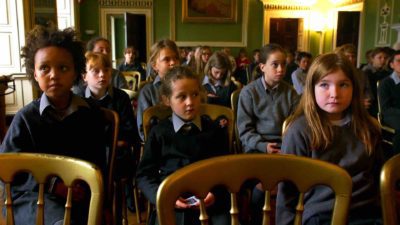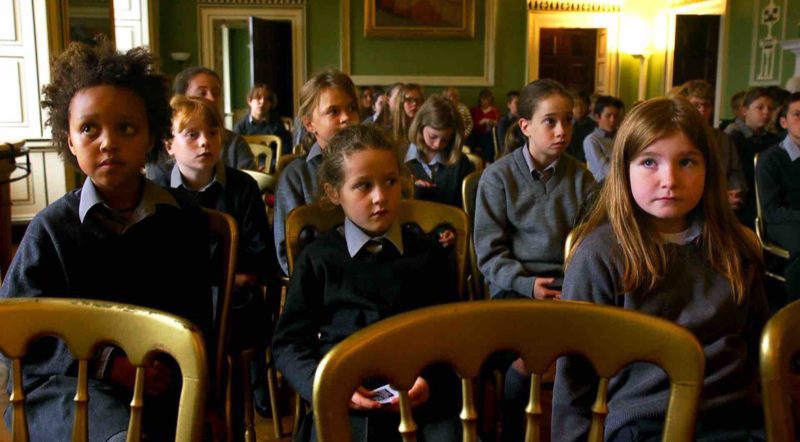INTERVIEW: ‘School Life’ enrolls audiences at Irish primary-age boarding school

School Life, the new documentary from Magnolia Pictures, spends a full academic year at Headfort, a primary-age boarding school in Ireland that offers a fresh approach to education. Within these 18th-century buildings, young children learn the value of freedom and expression, enjoying the worlds of art, music and sports.
At the center of the school is John and Amanda Leyden, who have been working at Headfort for almost 50 years. The married couple brings rock music into the curriculum right up alongside the classics in literature. Math? Sure. Latin? Of course.
Filmmakers Neasa Ní Chianáin and David Rane know the school well. In fact, their two children attend Headfort, and it was this personal connection that first interested them in making School Life, which opens Friday, Sept. 8 in New York City.
“Well, we were living in northwest Ireland in Donegal, and we have two children,” Rane said in a recent phone interview. “At the time, they were in primary level, and they were attending a small Catholic school, which we thought was idyllic because it was out in the middle of nowhere with three teachers teaching the entire school. But we realized it was quite restrictive, quite limited, quite homogenous, and our children were not really getting a very diverse education, not meeting different cultures, different communities. So Neasa and I started looking for a school for our children, and we explored alternative schools around Ireland.”
Ireland is a country where the Roman Catholic Church oversees many, many schools. Finding alternative choices is not always that easy, so the filmmakers scoped the available options, always looking for places that emphasized freedom and independence. Eventually their focus fell on Headfort.
“We found the Headfort website, and decided to visit the school and have a chat with the headmaster,” Rane said. “He had written this amazing letter on his website for prospective parents about educating the whole child, not just focusing on one specific area of academia, that kind of thing. … Neasa and I had both been to boarding school, and Neasa had a great time. And I had a terrible time, and so we decided that it would be really interesting how boarding schools had changed in the 21st century.”
They had their documentary in mind, but it took a lot of convincing to have Headfort and the school’s board to sign up for the project. Sometimes gaining access to a school can be more difficult than gaining access to a government building. Red flags start go up when the cameras start to record.
“We did a year of research, and then we had to kind of negotiate the access with the various teachers,” Chianáin said. “With John and Amanda, they had absolutely no interest in a film being made about the school. It took a whole year before they finally kind of realized that we were serious about making the film, and they invited us to their house for a tea. And we had a conversation. At this stage, our children had been there for a year, so we had a sense of how the school had affected or had an impact on them. And we had a conversation about what the school meant to us, and they talked about what the school meant to them. And about a week later, they came back to us, and they said, ‘OK, if you want to make a film, we’re in.’ So that was it.”
The filmmaking team has made a few feature-length documentaries. Both of them are interested in long-form storytelling, allowing for an audience to drop into a world and scope it out for a length of time.
“We always knew we wanted to do a feature length,” Rane said. “We had to pitch it and obviously try and raise funding, which was extremely difficult. No one in post-recession Ireland was interested in a film about a private school from the funding end, so there was a lot of convincing. … We spent a year researching, and during that year, we shot a little bit of footage. And we had material to show to try and convince people that there were great characters, [that] there was a potential for a feature-length doc in there.”
Many themes emerge from School Life. Besides telling a simple, positive story about teachers and students, the movie also offers insight into what’s missing in the education system.
“I think we’ve lost sight of childhood, and I think what this school offered was a safe environment and a lot of freedom for children to discover who it is they are,” Chianáin said. “I think the school kind of provides an old-fashioned childhood, a childhood away from screens, a childhood where kids can climb trees, where they can build forts, where kids learn to read, where they are introduced to the world of literature in a very dynamic way. And they’re given a range of areas that they might find a space for themselves.”
School Life played the Sundance Film Festival and received instant acclaim from audiences. That led to Magnolia coming on board and setting up a distribution plan.
“It’s festivaled around the world now, and we’ve attended quite a few of the festivals,” Chianáin said. “It’s just been really reassuring that the reaction that we get from teachers all over the world from all different types of pedagogy [is that they] recognized something in the film that is important and that they feel is missing sometimes in the educational system. And I think what John and Amanda embody in how they reach children is something quite special.”
Rane added: “It is a film that makes you laugh and cry, and makes you feel good about the world, which is a really nice place to leave people at the end of a documentary because, as you know, most documentaries are challenging and hard. And at the end, you feel like, oh my God, this is a difficult world we live in.”
By John Soltes / Publisher / John@HollywoodSoapbox.com
School Life opens Friday, Sept. 8 in New York City. Click here for more information.

